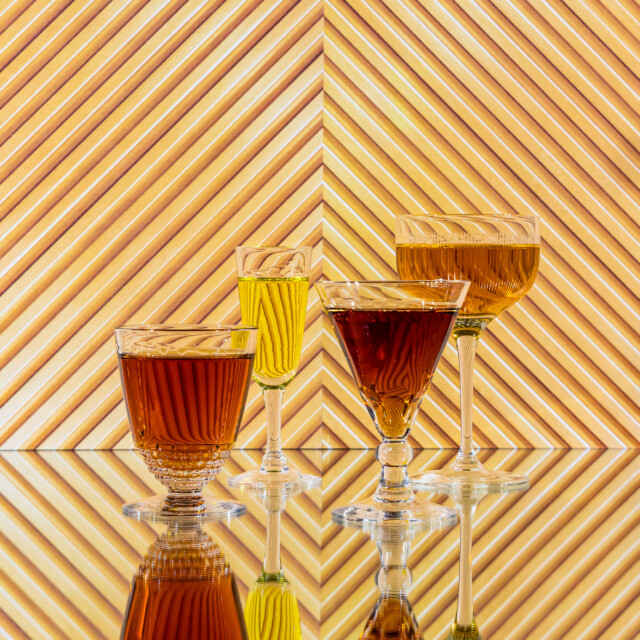A few months ago, I enjoyed one of those lovely, lengthy meals where several hours spent in the embrace of a restaurant slipped away over a procession of dishes. I felt transported, and just as it was all wrapping up and I realized that, probably, at some point — likely soon — my friend and I would be expected to leave the dining room and return to our own lives, the server brought out a couple of petite but tall, spindly glasses along with a few bottles of amaro. She invited us to sample a couple of styles, and while the amaro was good, it was the hospitality of the moment that moved me. Just as I felt the meal coming to a close, this server created a final, unexpected moment that extended the evening just a little longer.
Of course, I’d had amaro before, but part of what made the experience so special were the glasses, which took the digestif from an afterthought to a full moment — a little pomp and circumstance that I coveted. I assumed it would be expensive, but I knew I wanted to get some for myself. The following weekend, at a thrift store, I found a set of four similarly etched glasses for just $10 — I was delighted.
To get a few more ideas about what to do with my new favorite stemware, I called up Lynnette Marrero, a much-awarded mixologist who happens to have a bit of an obsession with vintage glassware. Her interest started with an old mixing glass and set of glasses that once belonged to her grandfather. The vessels I had fallen in love with, she told me, are called cordial glasses.
“They’re really just smaller, stemmed glasses,” she explains. “They’re usually about two ounces maximum.”
These small glasses were popular in the 1950s for sipping digestifs like sherry and Madeira but fell out of favor as these fortified wines did, leading to a lot of sets collecting dust in china cabinets before being donated to thrift stores by disinterested children and grandchildren. You can find modern versions being made if you look hard enough, but browsing thrift stores (or vintage Etsy shops) will lead you down far more interesting paths.
“I think a lot of people don’t know what to do with small glasses,” Marrero says. “I think that’s why you see them in stores a lot. But there are truly so many ways to use them.”
I had planned to use my new set mostly the way they’d used them at the restaurant: brought out with a bottle of amaro and maybe some fruit at the end of a meal. But Marrero says she also enjoys using them for pairings.
“I love them when I’m doing things like a cheese board,” she says, “and I want people to try different things, like rum with cheese and Scotch with cheese. I can use cordial glasses in that way to have smaller sips of everything.”
She also likes pulling them out for stronger drinks, like shots at a party or anything overproof like whiskey or mezcal, whether with food at a meal or simply because they look so beautiful.
This is in line with the classic use of cordial glasses, which was to serve things that had intense flavors and slightly higher alcohol levels — anything from sweet limoncello in Italy to a bitter Chartreuse in France, both of which are a bit intensely flavored to serve much more than a single ounce at a time. These days, amaro is perhaps the best known after-dinner drink for most young American restaurant diners, but the Italian liqueur’s popularity is an indication that people might be looking for more nightcap options.
Brandon Thrash, general manager at Middle Child Clubhouse in Philadelphia, longtime bartender, and self-described sherry obsessive, thinks aromatized wines of all kinds deserve a place in all our refrigerators. “I love something like sherry or vermouth in a restaurant,” he says. “But at home, it’s even better because fortified wines have a longer shelf life in your fridge than a typical wine does.”
Thrash recommends looking for biologically aged sherry for before dinner, and an oxidative style like oloroso or amontillado for after. For vermouths, he follows a similar rule: blanc or dry vermouth as an aperitivo, and sweet vermouth or vermouth di Torino after a meal.
When shopping for these kinds of glasses, Marerro recommends considering the weight of the glass — many of them are very thin and etched, which indicates quality, though you’ll rarely pay more for them than a couple of dollars. The exception to that rule is leaded glass, a very old and more expensive style that is harder to find. Part of the pleasure of adding cordial glasses to your cabinets, though, is the ability to use them casually — Marrero loves mixing and matching. Sets like the one I found are nice, but a variety is just as fun. Let your guests pick their favorite glass, and invite them to stay just a little while longer.
